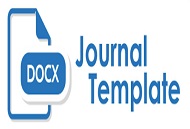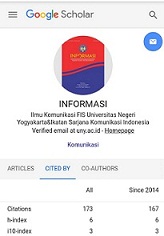Quran, name, and scientific communication
DOI:
https://doi.org/10.21831/informasi.v51i2.46749Keywords:
Quran, Name and Language, Scientific CommunicationAbstract
The objective of this study is to investigate the views of the Qur'an about the origin of the name and its position in relation to language and the development of science. The research model is literature research utilizing the sources collection (heuristic), source criticism, interpretation, and writing. The findings of this study are: (1) the Qur'an states that Allah SWT gives teachings about the names to the Prophet of Adam As; (2) These names correlate with the language because they are composed of the names that have been introduced to the Prophet Adam As; (3) The name and language are two sides of money; (4) Names, languages, and concepts can further be the main capital that humans have to develop scientific communication.
References
Al-Mahalli, J. & As-Suyuthi, J. (1985). Tafsir al-Jalalain. Dar Ibn Katsir.
Cassirer, E., & Nugroho, A. A. (1990). Manusia dan kebudayaan: Sebuah esai tentang manusia. Gramedia.
Collins, P. (2009). Philosophy and Humanism. Philosophia, 37(2).
Hurd, J. M. (2000). The transformation of scientific communication: A model for 2020. Journal of the American society for information science, 51(14), 1279-1283.
Hurd, J. M. (2004). Scientific communication: new roles and new players. Science & Technology Libraries, 25(1-2), 5-22.
Ikhwan, M. (2010). Western studies of the Quranic narrative: from the historical orientation into the literary analysis. Al-Jami'ah: Journal of Islamic Studies, 48(2), 387-411.
Iyengar, S., & Massey, D. S. (2019). Scientific communication in a post-truth society. Proceedings of the National Academy of Sciences, 116(16), 7656-7661.
Keohane, R. O., Lane, M., & Oppenheimer, M. (2014). The ethics of scientific communication under uncertainty. Politics, Philosophy & Economics, 13(4), 343-368.
Mitroff, I. I., & Mason, R. O. (2012). Creating a dialectical social science: Concepts, methods, and models (Vol. 25). Springer Science & Business Media.
Nasr, S. H., Dagli, C. K., Dakake, M. M., Lumbard, J. E., & Rustom, M. (2015). The Study Quran. A new translation and commentary, 19.
Nurtawab, E. (2020). Quranic readings and Malay translations in 18th-century Banten Qurans A. 51 and W. 277. Indonesia and the Malay World, 48(141), 169-189.
Quthb, S. (2003). Tafsir fi Zhilalil Quran. Jilid 9. Penerjemah: As'ad Yasin dkk. TIM GIP.
Ricoeur, P. (1976). Interpretation theory: Discourse and the surplus of meaning. TCU press.
Rohmana, J. A. (2015). Metrical verse as a rule of Quranic translation: Some reflections on RAA Wiranatakoesoema's soerat Al-Baqarah (1888-1965). Al-Jami'ah Journal of Islamic Studies, 53(2), 439-467.
Russell, B. (2001). The problems of philosophy. OUP Oxford.
Sastrapratedja, M. (1982). Manusia multi dimensional: Sebuah Renungan Filsafat. PT. Gramedia.
Shakespeare, W. (2017). Romeo and Juliet, Act II, Scene II. The Oxford Shakespeare (1914 edition).
Shihab, M. Q. (2008). Tafsir Al-Misbah: Pesan, kesan, dan keserasian alquran, Jilid 7. Lentera Hati.
Shihab, M. Q. (2012). Tafsir Al-Misbah: Pesan, kesan, dan keserasian alquran, Jilid 10. Lentera Hati.
Shihab, M. Q. (2012). Tafsir Al-Misbah: Pesan, kesan, dan keserasian alquran, Jilid 13. Lentera Hati.
Shihab, M. Q. (1996). Wawasan Al-Quran: Tafsir tematik atas pelbagai persoalan umat. Mizan Pustaka.
Shihab, M. Q. (2006). Tafsir Al-Misbah: Pesan, kesan, dan keserasian alquran, Jilid 1. Lentera Hati.
Sumarlan, I., Firmansyah, R., & Darmawan, H. (2021). Alquran communication patterns and efforts to build positive communication. Journal of Social Studies (JSS), 17(2), 255-270.
Wheeler, B. (2021). Quran as scripture in classical Muslim scholarship. Religions, 12(11), 1013.
White, H. D., Cooper, H., & Hedges, L. V. (2009). Scientific communication and literature retrieval. The handbook of research synthesis and meta-analysis, 2, 51-71.
White, L. A. (1949). The science of culture, a study of man and civilization.
Downloads
Published
How to Cite
Issue
Section
Citation Check
License
Authors who publish with this journal agree to the following terms:
- Authors retain copyright and grant the journal right of first publication with the work simultaneously licensed under a Creative Commons Attribution License that allows others to share the work with an acknowledgement of the work's authorship and initial publication in this journal.
- Authors are able to enter into separate, additional contractual arrangements for the non-exclusive distribution of the journal's published version of the work (e.g., post it to an institutional repository or publish it in a book), with an acknowledgement of its initial publication in this journal.
- Authors are permitted and encouraged to post their work online (e.g., in institutional repositories or on their website) prior to and during the submission process, as it can lead to productive exchanges, as well as earlier and greater citation of published work (See The Effect of Open Access).












